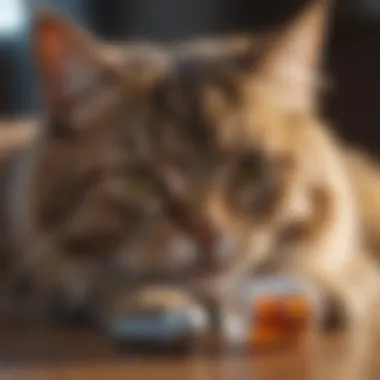Administering Flea Pills to Cats: A Practical Guide


Intro
Administering flea pills to cats is a crucial element of responsible pet ownership. Fleas can cause discomfort, transmit diseases, and trigger allergic reactions in cats. Thus, understanding the process of administering these medications is vital. This guide aims to elucidate the various aspects of this task and help pet owners navigate potential challenges effectively. The following sections will cover practical techniques, care considerations, and the significance of consulting veterinary professionals in the medication process.
Animal Overview
Common Name and Scientific Classification
Cats, scientifically known as Felis catus, are domesticated mammals belonging to the family Felidae. They are among the most popular pets worldwide and are appreciated for their independence and companionship.
Physical Characteristics
Cats are known for their agility, sharp retractable claws, and keen senses. They typically possess a supple body, which varies in size and coat length depending on the breed. Most have a wide range of fur patterns and colors, enhancing their appeal as pets. Their large, expressive eyes are adapted for low-light vision, which is an evolutionary trait beneficial for hunting.
Habitat and Distribution
Originally, domestic cats are descended from wild felines found in various habitats, including forests, grasslands, and human settlements. Today, they thrive in diverse environments around the globe, adapting superbly to urban and rural settings alike.
Administering Flea Pills
Giving medication to cats can prove to be a challenge for many owners. Cats are known to be picky eaters and often resist ingesting pills. Here are steps and strategies to efficiently administer flea pills:
Preparation
- Gather all necessary supplies: the flea medication prescribed by a veterinarian, treats, and possibly a towel.
- Read dosing instructions carefully to ensure correct administration.
Method of Administration
- Direct Method
- Pill Pockets or Treats
- Crushing the Pill
- Hold the pill between your thumb and index finger.
- Open the cat's mouth gently with the non-dominant hand by pressing on the upper jaw.
- Quickly place the pill as far back on the tongue as possible and close the mouth.
- Rub the throat gently to encourage swallowing.
- Utilize commercially available pill pockets. Mould the treat around the pill to mask the taste.
- Observe your cat to ensure he/she eats the entire treat.
- If appropriate, crush the pill and mix it with a small amount of wet food.
- Always consult the veterinarian to verify if the pill can be crushed.
Post-Administration Care
- Monitor your cat for any adverse reactions after administering the pill. Look for signs such as vomiting or lethargy.
- Maintain regular preventive measures against fleas, including treatments as prescribed by your veterinarian.
"An informed pet owner can greatly enhance a cat's well-being by ensuring proper medication usage."
Importance of Veterinary Consultation
Consulting a veterinarian is paramount before starting any flea medication. They can evaluate your cat's health to prescribe the right treatment and ensure that no underlying conditions are exacerbated.
Veterinarians can also provide valuable insights into the appropriate dosage and timing for administering flea pills, ensuring maximum efficacy.
The process of administering flea pills to cats can be simplified with understanding and preparation. By following the provided guidelines and ensuring veterinary guidance, pet owners can protect their feline companions against the discomfort caused by fleas. This will ultimately contribute to their overall health and happiness.
Understanding Flea Infestations
Flea infestations are a significant concern for cat owners. It is crucial to understand the underlying issues linked to these pests. A flea infestation can lead to various health problems in cats, impacting their overall well-being. Fleas feed on the blood of their host, causing discomfort and potential health complications.
The Impact of Fleas on Cat Health
Fleas are more than just annoying insects. They can be a source of severe health issues for cats. When fleas bite, they can cause skin irritation, allergic reactions, and anemia in some cases. The saliva of fleas contains proteins that may trigger allergies in sensitive cats. This condition, known as flea allergy dermatitis, results in extreme itching, leading to skin infections due to constant scratching. Moreover, fleas can transmit other diseases. For example, they can carry the tapeworm, which can infect your cat when it ingests an infected flea during grooming.


To avoid these complications, it is vital for cat owners to recognize the critical impact fleas can have on their pets. Regular flea control and immediate treatment upon noticing signs of infestation can lead to healthier, happier cats. The emphasis should be on prevention and prompt action when a flea encounter occurs.
Signs of Flea Infestation
Recognizing the signs of a flea infestation can prevent further complications for your cat. Some common signs include:
- Excessive scratching: Cats may scratch themselves more than usual, especially around their neck, back, and tail.
- Hair loss: Frequent scratching can lead to localized hair loss or thin patches on the cat’s body.
- Red or irritated skin: Look for rashes or inflamed areas, as these may indicate an allergic reaction.
- Flea dirt: This looks like tiny black specks and is a mixture of flea feces and dried blood. It often collects at the base of the fur.
- Visible fleas: Sometimes, you may spot adult fleas crawling through your cat's fur.
Being attentive to these symptoms enables cat owners to act swiftly. If you notice any signs, consulting a veterinary professional is a prudent course of action. Effective flea management begins with early detection.
Why Use Pills for Flea Treatment
Flea treatment for cats is vital, due to the discomfort and health risks fleas pose. Among various options available, oral medications, or pills, have gained attention. This method offers specific benefits that can help cat owners and their pets. Understanding why using pills for flea treatment is a practical choice helps in making informed decisions.
Effectiveness of Oral Medications
Pills for flea control are known for their effectiveness. Many products are designed to target fleas at different life stages. Once a cat ingests the pill, the active ingredients enter the bloodstream, affecting fleas that bite the cat. This is particularly beneficial because it interrupts the flea lifecycle, reducing the overall population in the environment.
Inflamed skin or illness from flea bites can cause significant distress. Oral medications manage immediate discomfort and prevent future infestations effectively. According to studies, some oral treatments can kill fleas within 30 minutes. This rapid action means relief can come quickly, making them a desirable choice for owners concerned about their pet's well-being.
Comparison to Other Flea Treatment Options
While topical treatments like Frontline and Advantage have been popular, they can sometimes be less effective in certain scenarios. For instance, thick fur can hinder the application of topical solutions. Moreover, cats that groom frequently may lick off the medication before it fully absorbs.
Besides topical treatments, there are also flea collars, but they may not provide the immediate relief that pills do. Collars oscillate between efficacy and convenience, but the oral route can be more targeted.
In summary, while other options exist, the pills often offer unique advantages such as rapid effectiveness and minimal external application. For pet owners seeking simplicity and effectiveness, pills present a compelling option.
"Choosing the right treatment requires consideration of convenience and effectiveness to ensure your cat remains happy and healthy."
Cycling through various treatment options is essential. Each cat's response may vary depending on individual health and preferences. Consultation with a veterinarian before deciding on a treatment plan is important, as they can provide tailored recommendations.
Preparing to Administer the Flea Pill
Administering flea pills to cats can be a challenging but necessary task for maintaining their health. Proper preparation is key to ensuring that the process goes smoothly. This stage involves more than simply placing the pill in front of your cat; it requires strategic planning to improve the likelihood of successful ingestion. Understanding the nuances of this preparation phase can make the experience less stressful for both the owner and the pet.
In this section, we will discuss two critical elements: choosing the right time and gathering necessary supplies. By addressing these considerations, pet owners can enhance the effectiveness of the treatment and contribute positively to their cat's overall well-being.
Choosing the Right Time
Timing holds significant importance when administering flea pills to your cat. A cat’s mood and behavior can fluctuate throughout the day, impacting their willingness to cooperate. Observing your cat’s daily routine can offer insights into the optimal moment for administering the pill. Preferred times often coincide with quieter periods when the cat is relaxed.
Moreover, consider the cat's feeding schedule. Administering the pill shortly after a meal can aid in the experience. Many cats tend to be calmer after eating, and they may take the pill more readily if it's mixed in food. The use of a consistent schedule helps in establishing a routine, which can also reduce anxiety for the cat.
Gathering Necessary Supplies
Having the right supplies at your disposal simplifies the administration of flea pills. Ensure that you have the pill itself, of course, but also consider the following items:
- Treats: Certain treats can work well as disguises for the pill.
- Pill Pockets: These are specially designed to hold pills, making them more appealing to your cat.
- Syringe or Pill Popper: These tools can help deliver the tablet directly if your cat is resistant.
- Towel: A towel can be useful to wrap your cat in, providing calm and stability while minimizing movement.
Adopting a methodical approach to organizing your supplies can lead to more effective administration. If everything is in place before you begin, you reduce the chance of stressful interruptions during the process.
"Preparation is half the battle, especially when dealing with skittish pets like cats."
Ultimately, preparing for the administration of flea pills involves being mindful of your cat's needs and ensuring that you have everything necessary to facilitate a smooth experience. By timing the process thoughtfully and gathering the appropriate tools, you empower yourself as a pet owner while safeguarding your cat's health.
Techniques for Administering the Pill


Administering pills to cats can be a complex task, especially when addressing flea infestations. Proper techniques not only ensure the medication is delivered effectively, but also minimize stress for both the cat and the owner. Understanding various approaches can empower pet owners to choose the most suitable method, fostering a more harmonious experience.
Direct Oral Administration Method
The Direct Oral Administration Method is often the most straightforward way to give a flea pill to a cat. This method requires the owner to directly place the pill in the mouth of the cat. Start by gently holding the cat's head, tilting it back slightly. Use your other hand to open the cat’s mouth by applying pressure on the lower jaw. Place the pill at the back of the tongue, then close the mouth while rubbing the throat gently. This encourages swallowing. It is essential to act calmly and quickly. This method works well for cats that are relatively calm and accustomed to human handling.
Using Treats to Facilitate Ingestion
Utilizing treats can be an effective and pleasant way of administering flea pills. Many cats respond positively to food, and this can significantly help. Choose a soft treat your cat enjoys. Hide the pill inside the treat, making sure it is well concealed. When given, the cat may not notice the medication. Observe your cat closely to ensure they consume the entire treat. This method often yields less resistance and is stress-free for both the owner and the pet.
Pill Pockets: A Strategic Solution
Pill pockets are another convenient alternative for administering flea medication. These are specially designed treats with a pocket to hold the pill. They are available in various flavors that appeal to cats. To use, simply insert the pill into the pocket, close it, and present it to your cat. The strong flavor often masks the taste of the medication. This method can increase the likelihood of successful pill ingestion, particularly for finicky eaters.
Alternative Solutions for Uncooperative Cats
Some cats may be more difficult and may resist pill administration. In such cases, consider using alternative methods. For instance, crushing the pill (if safe according to veterinary advice) and mixing it with wet food might be an option. Alternatively, a liquid form of medication could be prescribed by a veterinarian. Another approach involves using a pill dispenser device, which can help place the pill directly into the throat without too much handling. Understanding these alternatives is crucial; this ensures that your cat receives the necessary medication, despite any initial resistance.
It’s important to remain patient and gentle during the process to alleviate fear or anxiety in your cat.
Choosing the right technique for a specific cat will depend on the individual pet's temperament and preferences. Each method has its advantages and drawbacks, making it essential to evaluate which works best for both the owner and the feline companion.
Post-Administration Care
Post-administration care is crucial in ensuring the health and safety of your cat after giving flea pills. The right post-care methods can enhance the effectiveness of the medication and prevent any potential complications. Here are key aspects of post-administration care that every pet owner should consider:
- Monitoring responses: Keeping an eye on your cat after pill administration helps identify any immediate reactions.
- Supporting health: Ensuring your cat stays hydrated and nourished is vital for recovery and overall health.
Regular checks can help in catching any adverse effects early, making this phase equally important as the administration of the pill itself.
Monitoring for Immediate Reactions
After administering a flea pill, it is important to observe your cat closely for any immediate reactions. Some cats may have sensitivities to certain ingredients found in flea medications. Possible reactions can include:
- Vomiting
- Diarrhea
- Excessive drooling
- Lethargy or decreased energy levels
If you notice these or any other unusual behaviors, it may require further investigation. It is crucial to document these signs and consult a veterinary professional if they persist. Open communication with your vet can provide necessary insights about the specific medication your cat received.
Important: Always keep the medication package or label handy, as it contains essential information regarding dosage and side effects.
Ensuring Hydration and Nourishment
Hydration and proper nourishment are vital for your cat's well-being after administering flea pills. A medication can sometimes cause a temporary decrease in appetite or make them feel nausea. To counter this, here are some strategies:
- Provide Fresh Water: Ensure that clean and fresh water is available at all times. Cats are more likely to drink if the water is changed regularly.
- Monitor Eating Habits: Encourage eating by offering their favorite foods or treats. Some cats may need a little coaxing to resume normal eating habits.
- Consider Nutritional Balance: Look into slightly altering their diet. Offering special wet food can entice them to consume more.
Keeping track of your cat's food and water intake helps gauge their recovery status.
Proper post-administration care ensures that your cat not only reacts well to the flea medication but also maintains overall health during the treatment process. This diligence from pet owners emphasizes their commitment to their cats’ well-being.
Consulting with a Veterinary Professional
In the realm of pet care, consulting with a veterinary professional stands as a cornerstone of ensuring the health and well-being of your cat. This guidance is not merely a suggestion but a vital part of responsible pet ownership. Flea infestations can lead to significant health issues for cats, making it essential to understand when and how to seek professional help. The expertise of a veterinarian not only provides clarity on the most suitable flea treatment options but also addresses individual health concerns of your pet.
Engaging a vet brings forth numerous benefits. First, veterinarians have comprehensive knowledge of medications available in the market, including flea pills. They can recommend the most effective options based on your cat's age, weight, and overall health. Second, they can offer insights about potential interactions with other medications your cat might be taking. Understanding these interactions is crucial as they could affect the effectiveness of flea treatment or lead to adverse effects.
Additionally, a vet's assessment includes evaluating the severity of a flea infestation. If your cat shows severe signs of discomfort, a vet can suggest immediate interventions that can alleviate suffering. Beyond immediate solutions, a good veterinarian can also provide strategic advice on long-term flea prevention, helping avoid recurring infestations.


The veterinary consultation should not only occur following an infestation but should also be part of routine check-ups. Regular examinations can help catch problems before they escalate into serious health issues, ensuring your cat maintains optimal health. In summary, the role of a veterinary professional is indispensable in administering flea pills and maintaining your cat's health.
When to Seek Professional Assistance
You might wonder when exactly you should consult a veterinarian regarding flea treatment. A good rule is to consider veterinary help if your cat displays any of the following signs:
- Severe scratching or grooming: If your cat is scratching excessively or often bites at their skin, it may indicate a severe flea problem.
- Flea dirt: Discovering tiny black specks on your cat’s skin or fur can show the presence of fleas.
- Skin infections: Open wounds or signs of infection resulting from scratching may require medical attention.
- Weight loss or lethargy: If your cat appears unusually tired or is losing weight, these could be signs of a more significant health issue possibly linked to fleas.
It is also advisable to seek professional guidance before administering any flea medication. This ensures both safety and effectiveness for your cat’s treatment plan.
Understanding Medical Advice for Your Cat
Once you’ve consulted a veterinarian, understanding the medical advice you receive is critical. Veterinary recommendations may include several aspects:
- Medication type: Knowing why a specific flea pill was prescribed is essential. Each medication has its unique action, and some work better for particular age groups or health conditions.
- Dosage instructions: Following the correct dosage is vital. Misadministration can lead to ineffective treatment or worse, toxicity.
- Possible side effects: Awareness of potential side effects helps in monitoring your cat after administering the flea pill.
- Follow-up care: Understanding follow-up protocols ensures that if treatment does not seem effective, you can act promptly.
Ultimately, the cooperation between you and your veterinarian fosters an environment of care that prioritizes your cat’s health. By adhering to professional guidance, you can fortify your efforts against flea infestations, paving the way for a healthier life for your feline companion.
Frequently Asked Questions about Flea Pills
The section on Frequently Asked Questions about flea pills is critical in enlightening both seasoned pet owners and newcomers. This area provides insights into common queries that arise during the administration process. Understanding these issues is not just about convenience but also ensuring the overall health and safety of your feline friends.
A diverse range of concerns often comes up among pet owners. Addressing these can help demystify the process of flea management with pills and encourage proactive care for cats. Moreover, addressing these frequently asked questions can mitigate anxiety surrounding the treatment.
Common Concerns from Pet Owners
Pet owners may worry about the safety and efficacy of flea pills. Questions often arise regarding age restrictions, side effects, and dosage. It is essential to clarify these points.
- Safety: Many flea medications are safe for cats of varying ages, but always check labels.
- Side Effects: Some may experience mild side effects, including vomiting or diarrhea. However, serious reactions are rare.
- Dosage: Following veterinary guidance on the dosage is paramount. Overdosing can lead to complications.
Addressing these points can alleviate concerns, enabling owners to focus on their pet’s well-being.
Interactions with Other Medications
It’s crucial to be aware that flea pills can interact with other medications. Consulting a veterinarian before starting a new treatment regimen is advisable.
- Antibiotics: Some antibiotics may reduce the effectiveness of oral flea medications. Verify with a vet to avoid this.
- Chronic Medications: If your cat is on long-term medications, inform the veterinarian before administering any flea treatment. This helps prevent adverse interactions.
- Holistic Remedies: If you are using alternative treatments, such as herbal solutions, discuss these with a veterinary professional. Some remedies can interfere with the action of flea pills.
It is in the best interest of your cat's health to thoroughly discuss any current medications with a professional. This ensures that you are fully aware of potential interactions that may affect treatment outcomes.
It’s essential to maintain open communication with the veterinarian, as knowledge is key in preventing complications during the treatment process.
Summary of Key Points
Administering flea pills to cats is an essential aspect of pet care that can significantly impact the health and well-being of your feline companions. Understanding the nuances involved in this process is crucial, as it not only ensures the proper dosage of medication but also helps in minimizing stress for both the owner and the cat.
In this article, we have highlighted specific best practices that can make the process smoother. These range from recognizing the best time to administer the medication to knowing how to react to possible side effects. One must ensure that the technique used aligns with the cat's temperament. Keeping a calm environment is pivotal.
Also, paying attention to post-administration care can establish a routine that is reassuring for your cat. Regular monitoring for immediate reactions after giving the pill is essential. Furthermore, ensuring that your cat remains hydrated, and takes in the necessary nourishment before and after administration can enhance the effectiveness of the medication and support overall health.
Lastly, the importance of consulting with a veterinary professional cannot be overstated. Whether it's about understanding specific medical advice or knowing when to seek help, veterinarians play a vital role in guiding pet owners. Knowledge is key in making informed decisions that contribute positively to cat health.
A well-structured approach to administering flea pills not only protects your cat from parasites but also strengthens the bond between pet and owner.
Recap of Best Practices
- Choose the Right Time: Administer the pill when the cat is calm and relaxed. This helps in reducing resistance and stress.
- Gather Supplies: Before starting, ensure you have all necessary items, including the flea pill, treats, and possibly a pill pocket for easier administration.
- Monitor for Reactions: After administration, observe your cat for any adverse effects, especially during the first few hours.
- Stay Calm: Your demeanor can influence how your cat reacts. Staying calm helps keep your cat relaxed.
- Consult a Veterinarian: Regularly check with your vet about the best practices suited for your cat's specific health needs.
Final Thoughts on Cat Health
Flea pills are an effective way to manage flea infestations, but the larger picture involves an overall health perspective for your cat. Incorporating a holistic approach to pet care means considering nutrition, environmental cleanliness, and routine veterinary check-ups.
In essence, administering flea pills is just one aspect of a larger responsibility that comes with being a cat owner. Getting it right enhances your cat’s comfort and health over the long-term. Remember, a healthy cat is a happy cat, and by ensuring proper flea control, you are investing in your pet's well-being.







